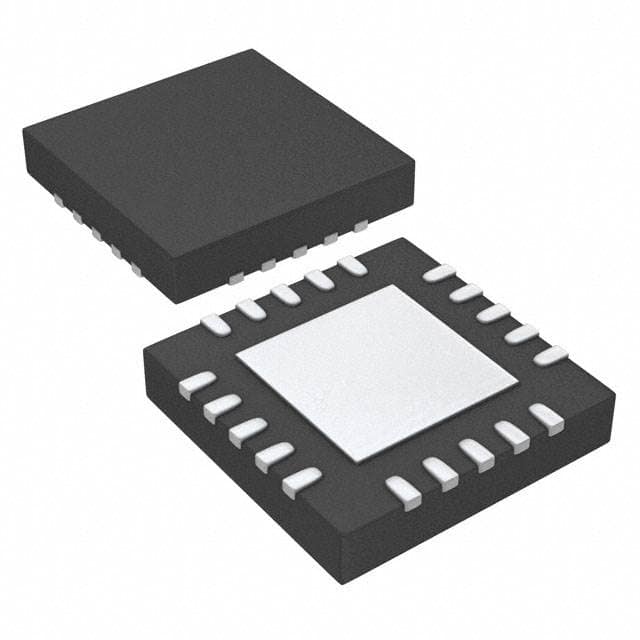Szczegóły produktu można znaleźć w specyfikacjach.

TPS2372-3RGWR
Product Overview
Category
The TPS2372-3RGWR belongs to the category of power management integrated circuits (PMICs).
Use
This PMIC is specifically designed for Power over Ethernet (PoE) applications.
Characteristics
- The TPS2372-3RGWR is a highly efficient and compact device that enables power sourcing equipment (PSE) to deliver power to powered devices (PD) over Ethernet cables.
- It incorporates various features such as detection, classification, and current limiting, ensuring safe and reliable power delivery.
- The device supports both IEEE 802.3af and IEEE 802.3at standards, making it compatible with a wide range of PoE-enabled devices.
- It operates at high efficiency, minimizing power losses and maximizing power transfer to the PD.
- The TPS2372-3RGWR is available in a small package, allowing for space-saving integration into PSE designs.
Package and Quantity
The TPS2372-3RGWR is offered in a 20-pin VQFN package. It is typically sold in reels containing a quantity of 250 units.
Specifications
- Input Voltage Range: 36V to 57V
- Output Voltage Range: 3.3V to 12V
- Maximum Output Current: 600mA
- Operating Temperature Range: -40°C to 85°C
- Efficiency: Up to 95%
- Integrated Protection Features: Overcurrent, Overvoltage, and Thermal Shutdown
Detailed Pin Configuration
The TPS2372-3RGWR features the following pin configuration:
- VDD: Power supply input
- GND: Ground reference
- VOUT: Output voltage
- CLASS: Classification resistor connection
- DETECT: Detection resistor connection
- ILIM: Current limit setting
- VREF: Reference voltage output
- FB: Feedback pin for voltage regulation
- EN: Enable pin for device control
- NC: No connection
- NC: No connection
- NC: No connection
- NC: No connection
- NC: No connection
- NC: No connection
- NC: No connection
- NC: No connection
- NC: No connection
- NC: No connection
- NC: No connection
Functional Features
- Detection and Classification: The TPS2372-3RGWR incorporates a robust detection mechanism that identifies the presence of a PD and determines its power requirements. It supports both 802.3af and 802.3at standards for accurate classification.
- Current Limiting: The device ensures safe power delivery by implementing current limiting functionality, protecting both the PSE and PD from excessive currents.
- Thermal Shutdown: To prevent overheating, the TPS2372-3RGWR features a thermal shutdown mechanism that disables the device when the temperature exceeds a specified threshold.
- Voltage Regulation: The PMIC maintains a stable output voltage, compensating for variations in input voltage and load conditions.
Advantages and Disadvantages
Advantages
- High efficiency leads to reduced power losses and improved energy utilization.
- Compact package allows for space-saving integration into PSE designs.
- Supports both IEEE 802.3af and IEEE 802.3at standards, ensuring compatibility with a wide range of PoE-enabled devices.
- Integrated protection features safeguard against overcurrent, overvoltage, and thermal issues.
Disadvantages
- Limited maximum output current may not be suitable for high-power applications.
- Operating temperature range may restrict usage in extreme environments.
Working Principles
The TPS2372-3RGWR operates based on the principles of Power over Ethernet (PoE). It receives power from the PSE and delivers it to the PD over Ethernet cables. The device performs detection and classification to identify the connected PD's power requirements accurately. It then regulates the output voltage and limits the current to ensure safe and reliable power delivery.
Detailed Application Field Plans
The TPS2372-3RGWR finds applications in various fields, including:
- IP Cameras: The PMIC can be used in PoE-enabled IP cameras to provide power and data connectivity over a single Ethernet cable, simplifying installation and reducing wiring complexity.
- Wireless Access Points: By integrating the TPS2372-3RGWR into wireless access points, power can be delivered efficiently, eliminating the need for separate power adapters.
- VoIP Phones: PoE-enabled VoIP phones can benefit from the TPS2372-3RGWR's power management capabilities, enabling easy deployment and flexibility in office environments.
Detailed and Complete Alternative Models
- TPS2372-2RGWT: Similar to the TPS2372-3RGWR, this model offers two output channels instead
Wymień 10 typowych pytań i odpowiedzi związanych z zastosowaniem TPS2372-3RGWR w rozwiązaniach technicznych
Sure! Here are 10 common questions and answers related to the application of TPS2372-3RGWR in technical solutions:
Q: What is the TPS2372-3RGWR? A: The TPS2372-3RGWR is a Power over Ethernet (PoE) powered device controller that integrates both the IEEE 802.3at-compliant PoE interface and a DC/DC converter.
Q: What is the maximum power output of the TPS2372-3RGWR? A: The TPS2372-3RGWR can deliver up to 25.5W of power to the connected device.
Q: Can the TPS2372-3RGWR be used with non-PoE devices? A: Yes, the TPS2372-3RGWR can be used with non-PoE devices by connecting an external power supply instead of using the PoE input.
Q: What is the input voltage range supported by the TPS2372-3RGWR? A: The TPS2372-3RGWR supports an input voltage range of 36V to 57V.
Q: Does the TPS2372-3RGWR support various PoE standards? A: Yes, the TPS2372-3RGWR is compliant with both IEEE 802.3af and IEEE 802.3at PoE standards.
Q: Can the TPS2372-3RGWR provide power to multiple devices simultaneously? A: Yes, the TPS2372-3RGWR can provide power to multiple devices through its multiple output channels.
Q: Is the TPS2372-3RGWR suitable for outdoor applications? A: Yes, the TPS2372-3RGWR is designed to operate in a wide temperature range and can be used in outdoor applications.
Q: Does the TPS2372-3RGWR have built-in protection features? A: Yes, the TPS2372-3RGWR includes various protection features such as overcurrent protection, overvoltage protection, and thermal shutdown.
Q: Can the TPS2372-3RGWR be controlled and monitored remotely? A: Yes, the TPS2372-3RGWR supports remote control and monitoring through its I2C interface.
Q: What are some typical applications of the TPS2372-3RGWR? A: The TPS2372-3RGWR is commonly used in applications such as IP cameras, wireless access points, VoIP phones, and other PoE-powered devices.
Please note that these answers are general and may vary depending on the specific implementation and requirements of your technical solution.

